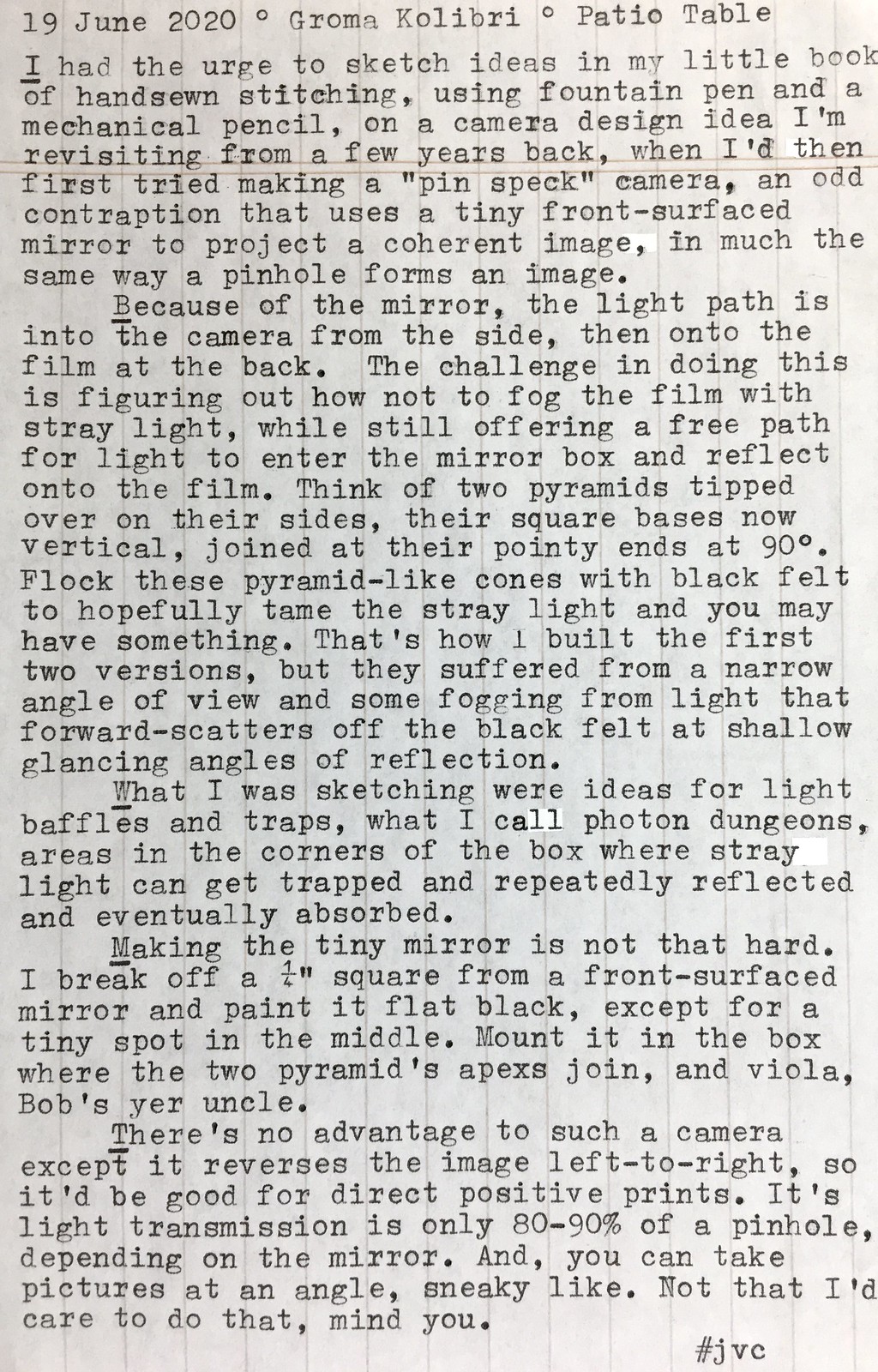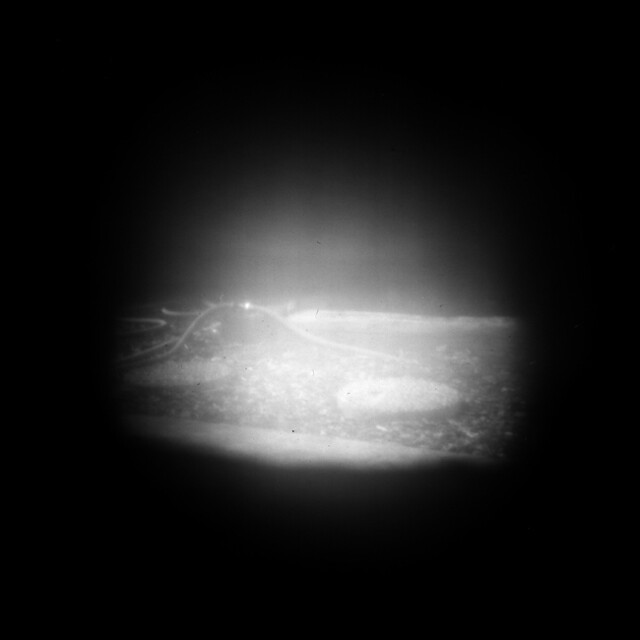Experimental Camera Sketching


In the top right hand portion of my sketch journal, the light path is defined by the dashed ink lines, which enter the camera on its left, into the mirror box area, then down onto the film. The various pencil lines define primary and secondary sources of potential light fogging, which I've attempted to minimize using various baffles and other means.
Here's a crop of a sketch of a simpler design that uses an angle of view just under 45 degrees, without all the complicated baffles:

The tiny mirror is in the upper right corner of the box. The light enters the box from the left, reflects off the tiny mirror to form a coherent, pinhole-like image, and onto the film at the bottom. The diagonal wall protects the interior from stray light. Any stray light that glances off the upper wall, past the mirror, will hopefully be absorbed by the flocked interior walls before fogging the film. These narrower angles of view are relatively easy to achieve. Still, an earlier test camera, from circa 2013, only showed marginal success:

As you can see, the image above was partially obstructed by the black felt covering the surfaces near the mirror box. The more felt used to cover the interior surfaces, especially near the mirror itself, the more obstruction results; less felt gives a wider angle of view but doesn't absorb stray light as well.
My newer design idea (at the top right sketch journal photo) is for a camera with a 60 degree angle of view, much more challenging than the 45 degree version. As I alluded to in the typed piece, even black felt can reflect light, if it's off the surface at a slight glancing angle, so-call "forward scattering". This new idea permits the film to "see" a black chamber behind the mirror, a space mostly devoid of stray light.
The primary fogging light comes from the left, through the gap between the open edge of the diagonal dividing wall and the mirror, then on to the right side of the camera. Here I've made a "photon dungeon", a space with non-parallel walls covered in black felt that will (hopefully) absorb the stray light, using a baffle wall that keeps this light from fogging the film. There's a secondary potential source of fogging, a view from the film to just left of the edge of this baffle wall, then into the upper right corner of the box behind the mirror. This corner space could be fogged by stray light from the primary fogging source, so I've included another wall dividing the two. So the film should "see" a mostly black space just to the right of the mirror.
Another decision is the lower wall of the inlet pyramid, on the left side of the camera. I could flock it with felt and make it follow just outside of the light path, but this would risk forward-scattering of light into and around the mirror box. Instead, I've chosen to make this side of the camera be the outer side of the diagonal dividing wall itself, with the light inlet mask at the left opening providing a shadow for this surface. Yes, light will reflect off this wall, but not at such a severe glancing angle.
There are further light baffles, providing photon dungeons, in the upper left corner of the drawing.
Another insight I had was the volume and size of the camera has a direct effect on the efficiency of the light-absorbing properties of the photon dungeons. Even though the film format may be, say, 4"x5", if the camera is made much larger, say at least 10" wide, those darkened interior spaces opposite the film, being much larger, will do a better job of absorbing light, due to the inverse square law causing more light intensity fall-off of stray light.
The thickness of the main diagonal dividing wall has a direct effect on the size of the gap between the open edge of the wall and the mirror. A thicker wall, flocked much heavier, will need a larger gap, in order not to obstruct the 60 degree angle of view; which in turn will cause more stray light to enter the camera. A thinner wall means its open edge can be closer to the mirror, providing a smaller gap for stray light to enter; but can a thinner wall still have low reflective (and forward scattering) properties? Maybe I need some of that new "vantablack" material, made from carbon nanotubes, that has less than 1% reflectivity.
Stepping back from the technical minutia of this project, there is no practical reason to build such a camera, except to be able to say that I built it. Conventional pinhole cameras do just fine. As do modern digital cameras and smart phones, for capturing photographic images. So what's the point? I think for me it's somehow tied into my long history of camera-making, especially oddball cameras employing strange or novel ideas. It's doing it for the sake of doing it.
Labels: camera making, pin speck camera, pinhole

3 Comments:
Challenging way to get an image. The final result shows some interesting character.
Both your sketches and the photo are magical and mysterious.
Hey, you got a picture of Jupiter with your Photon Dungeon! :D
Post a Comment
<< Home